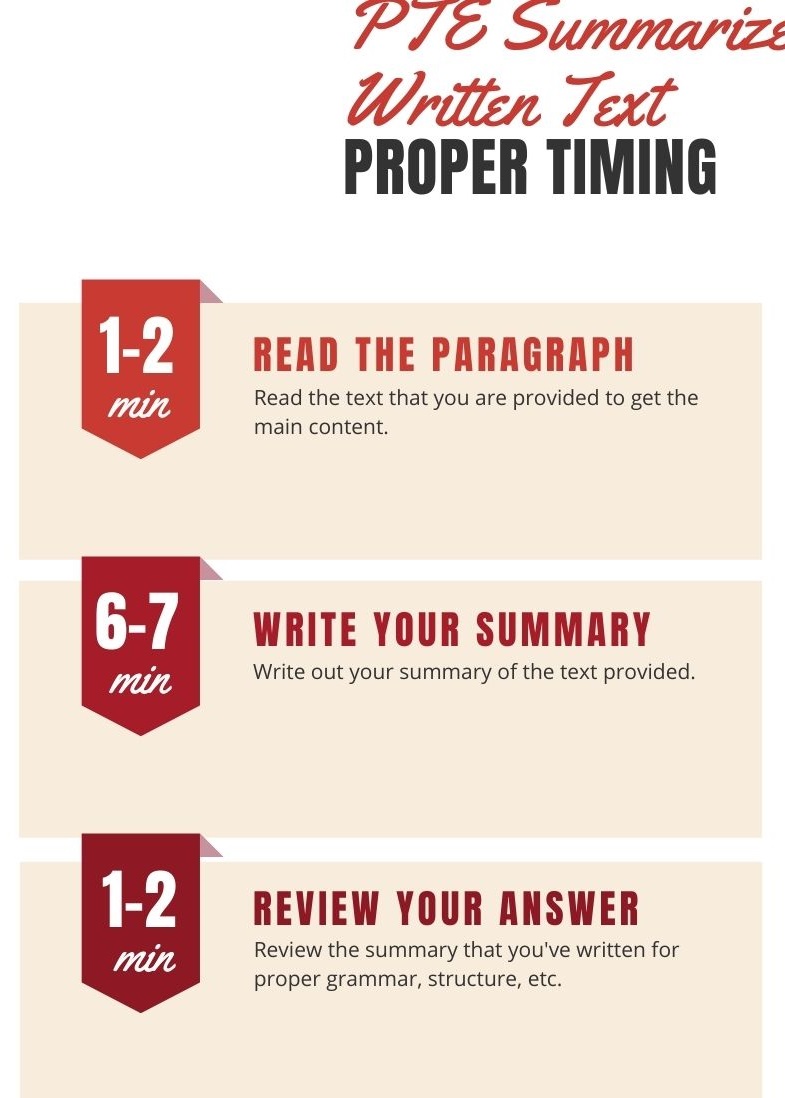Effective tricks to ‘Summarize Written Text’ during PTE Exam
- 0 Comments


You will have at least two pieces of content for the summarize written text section of your PTE exam, but you may have a total of three pieces. There are several different formats that the exam can have, so be prepared to have as many as three of these questions.
What You Get
You will receive a piece of text that is somewhere between 150 and 200 words in length. You will need to read the text and summarize it in 10 minutes. That means you need to be able to read quickly while still understanding the information that you read. Your summary needs to be at least 5 words or as many as 75 words.
What to Know
You need to know how to read quickly but still get all of the main information and important points out of the text. This is something that you can practice with any piece of text though official practice texts may help you even more. You need to make a plan for how much time you have for each part of completing this question type.
You will need to know how to summarize the text that you read into a short sentence. You can make your sentence up to 75 words, however it is very difficult to write a grammatically correct sentence that is that long. Instead, try to summarize the content in 40 to 50 words.
Organization will be very important to writing out your summary. If you can read and understand the text you are given you then need to know how to organize it so you can write a single sentence. Your sentence needs to make sense, so organization before you start writing is an important step.
Once you start writing the most important piece is grammar. You will need to use proper sentence structure to prove you understand it. This includes commas, semi-colons, colons, hyphens and anything else that is important to the sentence you write. It also means that your words must agree with each other in tense (past, present, future, etc.) and must be arranged in a way that makes sense.
You are not required to use all forms of grammar and punctuation in your summary. You can write a simple sentence that provides all of the important information. This will be the best way for you to work because it gives you the best chance at getting more points. It gives you less chance to make a mistake.
Breaking Down Your Time
When it comes to breaking down the time you need for each question on the summarize written text section you should consider what takes you more time.
1-2 minutes – Reading the paragraph or at least skimming over it for the most important points should not take you more than 2 minutes. You will now have 8 minutes remaining.
6-7 minutes – Writing out your summary should not take you more than 7 minutes. You will now have 1 minute remaining.
1-2 minutes – You should leave time at the end to review your answer and make sure that you have written it the way you want. This will fill the remaining time that you have.


General Tips and Plans
Even though you have a plan for how long every step should take don’t get too overwhelmed. You do not need to hold yourself to that specific timeline if it does not work for you. Practice reading a text and writing a summary to see where you may need more time or less time.
If you need a little longer to read but can write faster then you can adjust the timeline to fit you. You may want to break down the writing time so that you have a few minutes to organize your thoughts before you write. That may help speed up the writing process.
Allow yourself enough time in your review to make any changes necessary. If you notice a problem with the way you wrote your sentence you need to have enough time to change it before your time is up and your answer is turned in.
Here is a sample summarize written text answer for your reference. Make sure to write your own summarize written text answer based on the strategies we have discussed here.
sample summarize written text
Virtual reality has been used to help treat severe paranoia. Patients who suffered persecutory delusions were encouraged to step into a computer-generated Underground train carriage and a lift. The simulations allowed the study’s 30 patients to learn social situations they feared were actually safe.
The research at Oxford University, published in the British Journal of Psychiatry, was funded by the Medical Research Council. Members of one group of patients were told to use their normal defensive behaviour, such as avoiding eye contact. The rest of the patients were encouraged to lower their defences and try to learn they were safe by approaching computer characters (avatars) and standing toe-to-toe or staring at them. This group, who fully tested out their fears, showed the biggest reduction in their paranoid delusions. More than half of them no longer had severe paranoia at the end of the testing day. The first group, who used their defences, also saw some reduction in the level of severe paranoia. The study was led by Prof Daniel Freeman, a clinical psychologist at Oxford University’s Department of Psychiatry. He told me: “At the heart of paranoia is the unfounded belief that people are under threat. With virtual reality we can help the person to re-learn that they are safe, and when they do that, the paranoia melts away.”
The study was small and the patients had just one half-hour session of virtual reality with no long-term follow-up. However, Prof Freeman said the results were “exceptionally good”. He added: “I think this a glimpse into the future of mental healthcare. There is a revolution underway in virtual reality with many headsets becoming available.
Answer
Scientists claim that using virtual reality could revolutionize the treatment of patients suffering from severe paranoia and help them feel safe in social situations.
No matter how much you practice the PTE summarize written text you can always use a little more. Check out the sample questions and practice tests we have available to prepare yourself.











